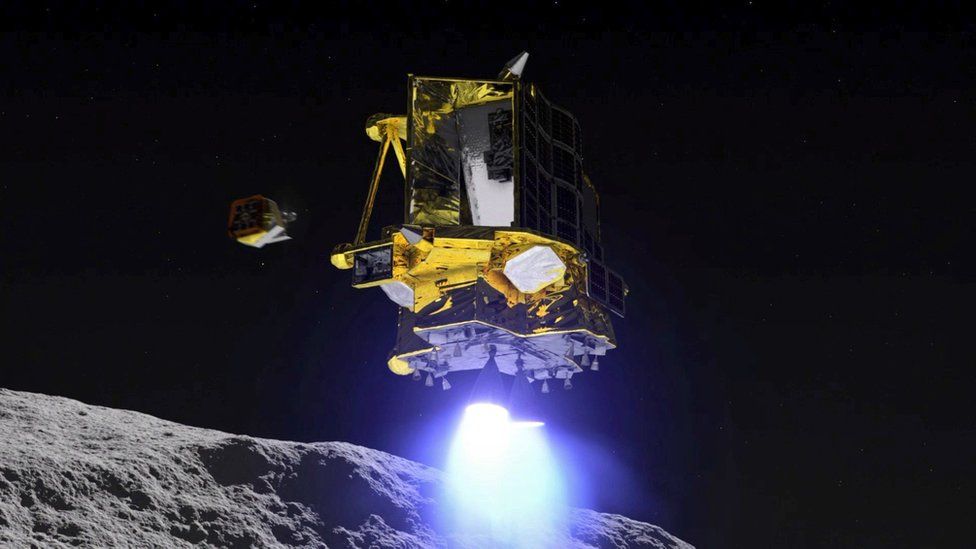ARTICLE AD BOX
 Image source, Jaxa
Image source, Jaxa
Artwork: Jaxa has become the fifth national space agency to land on the Moon
By Jonathan Amos
Science correspondent
A robot from Japan's space agency has successfully touched down on the Moon but problems with its solar power system may threaten its mission.
It makes the Asian nation only the fifth country to soft-land on Earth's natural satellite, after the US, the Soviet Union, China and India.
Called the Smart Lander for Investigating Moon (Slim), the mission put itself gently on the lunar surface near the Shioloi equatorial crater.
Japan is now in a race against time.
After the joy of seeing its Slim spacecraft successfully touch down on the Moon, engineers from the Jaxa, the country's space agency, quickly realised all was not well.
For reasons not yet fully understood, the craft's solar cells are not working. This means all surface operations are currently being run off Slim's batteries and the lander may have just a few hours of life ahead of it.
Officials are currently prioritising activities. They've turned off heaters and are now pulling down pictures from the craft and data that will tell them how well the landing software worked.
The agency won't immediately give up on Slim if it does fall silent. It's always possible the solar cells have somehow become oriented in a way that prevents them from seeing the Sun.
Asked at a news conference what could be done to try to fix the solar cells, Hitoshi Kuninaka, director general of the Institute of Space and Astronautical Science and vice-president of Jaxa, said: "The battery will last several more hours, those hours will be the remaining life of Slim", but they are trying to keep the "status quo".
Kuninaka said they didn't want to do anything that was "too excessive", but there is still hope for Slim to generate electricity again, when the solar angle changes.
"The solar angle will change every month and the sunlight on the Moon will change.
"When the light from Earth shines from a different direction it could hit the solar cell, so we are considering this and we are hoping for Slim to regain power."
He summarised by saying even if the Slim battery system runs out, and it catches the sun's light, it could restart.
The craft, which carries an infrared camera, was to spend the next fortnight studying the local geology.
Image source, Jaxa
Image caption,An artist's impression of the two rovers on board
Telemetry indicates Slim managed to eject the two small rovers it was carrying just before touch-down.
One is a 2kg device designed to hop across the surface. The other is a ball that can change its shape to raise a camera to take photos. One of the companies behind its development is Tomy, who created the Transformers toys.
Statistically, it's proven very hard to land on the Moon. Only about a half of all attempts have succeeded.
Jaxa put its faith in new precision-navigation technologies.
The lander's onboard computer used rapid image processing and crater mapping to avoid hazards and reach its touch-down point.
Engineers had wanted to get within 100m (330ft) of their targeted location and will now be studying data to see how well Slim performed.
Kuninaka said the "minimum success" criterion was landing on the Moon and that it would be considered "full success" if the craft landed within 100m of its target. While it may take a month to confirm this, Kuninaka says he believes this has been achieved.
An "extra success" would have been for the craft to perform its scientific observations. Due to the issues with the solar cells, it appears this has not been met, he said.
Slim began the descent manoeuvres from an altitude of 15km (9 miles) at midnight into Saturday, Japan Standard Time (15:00 GMT, Friday).
Shioli Crater is currently bathed in sunlight but the darkness of lunar night will return at the end of the month.
When that happens the spacecraft's solar panels won't be able to generate electricity and onboard components will likely break in the plummeting temperatures.
But if Slim can get through the next few days, see its two rovers work on the surface, and conduct a detailed investigation of Shioli's geochemistry, then Jaxa will consider all of its objectives have been met.
Jaxa has twice landed robots on asteroids, so this Moon landing is another feather in its cap.
It will be playing significant roles in the US space agency's (Nasa) Artemis programme, which seeks to put humans back on the lunar surface after a gap of more than half a century.
Last year, a private Japanese company, Ispace, had a go at landing. Its Hakuto-R craft crashed when the onboard computer became confused about its altitude above the Moon. It shut down its thruster system early, assuming the surface had been reached when in reality the mission still had another 5km (3 miles) to go.
On Thursday, the private American company Astrobotic disposed of its Peregrine landing craft in Earth's atmosphere. A propulsion fault prevented it from even trying to make a touch-down attempt.

 1 year ago
32
1 year ago
32








 English (US) ·
English (US) ·